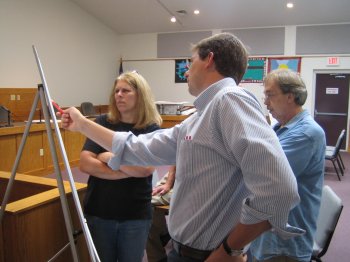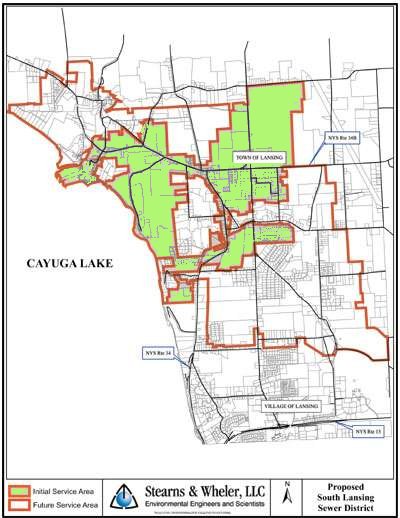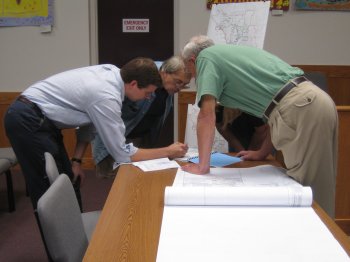- By Dan Veaner
- News
 Print
Print
On Saturday (9/16) Lansing's Sewer Committee hosted an open house at the Town Hall to give residents in the proposed sewer district a chance to get their questions answered. In contrast to public information meetings where everyone speaks in front of everyone else, the open house gave residents a chance to talk one on one with Town officials, committee members and engineers. "I think we've had a really good cross section of yays and nays," said Town Supervisor Steve Farkas. "People have asked some great questions, I think that the engineers are going to have to go back and look at."

Engineer Jim Blum explains the sewer project
The open house was part of the public information phase of the sewer project, during which residents learn about the project and have a chance to decide whether they want sewer to come to Lansing. " I think they set it up really well," said Linda Longhouse. She and husband John wanted to see if their Autumn Ridge property could be added to the proposed district. "They're very organized and they've handled this whole educating the community process really well, too, to put the information out there and help make the public as informed as possible."
Last week the Town sent a "Facts About the Sewer" mailer to all residents within the proposed district, and have information posted at www.lansingsewers.com. It summarized the project costs, scope and benefits, and included a map showing who is included in the overall district and areas included in the initial service area. Rob Bandler learned of the open house through the mailer. He is not in favor of sewer, but said he is willing to be convinced. "I mostly want more information," he said. "I want to see if someone can convince me that it's worth the increase in cost and tearing up the driveway and property and the roads and all that."
Jim Blum is the project manager from the Stearns & Wheler engineering firm that has been developing the project. With 17 years of experience working on sewer projects of all sizes, Blum says, "I think they're doing a very good job here. Municipalities handle the information phase in different ways." But he says it is difficult to predict whether the public will embrace a project or reject it. "In the beginning you see nay-sayers come out and oppose the project. A lot of people who may support the project are more hesitant to come forward and speak their minds based on the public opinions that they're hearing around them. So it's very difficult to predict the overall final result."

Proposed district with initial service area in green
Farkas estimated that morning participants in the open house were about 60-40 for the project. But he said that more people need to find out the facts so they can decide for themselves. "People are coming, but we need a lot more than that," he said. "When we talk about 1,700 EDUs in the district I certainly would like to see more people." Indeed, only 3.6% of those were present Saturday, amounting to just over 60 residents.
Sewer Committee Chairman and Deputy Supervisor Bud Shattuck said the communication goes both ways. "We're still looking to make changes," he said. "We'll listen to the people in the community and there may be changes made on different aspects, possibly road frontage, length of time they've had septic systems in the ground, if they've got a new septic system in the ground we may lengthen the years before they are forced to hook up."
Maps and documents were on display in the main room in the Town Hall, including copies of the engineer's report. An appendix in that report lists each property in the proposed district with a breakdown of costs for the trunk sewer, collection system, usage and operation and maintenance. In the 'worst case scenario' the average homeowner would pay $854 annually when hooked up to the sewer. Those in the district but outside of the initial service area would pay $148 for the trunk forced-main sewer that connects the Town to the Cayuga Heights treatment plant.
But these payments are likely to go down as more homes are built that will share the costs. A better loan rate would cut costs up front, as would contributions that the committee is soliciting. By the time residents are billed, the committee hopes the annual fee for a home that is hooked up will be as low as $548 annually. But they can't sell the public on the lower price tag, because at this point the actual cost is unknown.

"There may be questions we can't answer," said committee member Noel Desch. "Obviously the future is speculative. For example, the level of growth that we've seen in the past in the Town of Lansing will probably continue to happen. So the unit cost will go down as that takes place, and that's helpful." But he was pleased with the way the open house was working. "We've had people coming in a few at a time, which has been very helpful for them and for us to explain the district proposal," he said. "I think the people who have come in can now go back and talk with their neighbors and explain the details of the proposal."
Farkas and Shattuck estimate that the public information phase will run through the end of this year, giving them another three months or so to schedule more public information meetings and open houses. He said people seemed more comfortable talking one-on one, so the Town will definitely schedule more open houses. "They're getting personal service, and I think that's what people like to get," he said. They can ask the question, and hopefully they leave with something they can go home and think about. And I hope they come back and ask more questions."
----
v2i36

Engineer Jim Blum explains the sewer project
The open house was part of the public information phase of the sewer project, during which residents learn about the project and have a chance to decide whether they want sewer to come to Lansing. " I think they set it up really well," said Linda Longhouse. She and husband John wanted to see if their Autumn Ridge property could be added to the proposed district. "They're very organized and they've handled this whole educating the community process really well, too, to put the information out there and help make the public as informed as possible."
Last week the Town sent a "Facts About the Sewer" mailer to all residents within the proposed district, and have information posted at www.lansingsewers.com. It summarized the project costs, scope and benefits, and included a map showing who is included in the overall district and areas included in the initial service area. Rob Bandler learned of the open house through the mailer. He is not in favor of sewer, but said he is willing to be convinced. "I mostly want more information," he said. "I want to see if someone can convince me that it's worth the increase in cost and tearing up the driveway and property and the roads and all that."
Jim Blum is the project manager from the Stearns & Wheler engineering firm that has been developing the project. With 17 years of experience working on sewer projects of all sizes, Blum says, "I think they're doing a very good job here. Municipalities handle the information phase in different ways." But he says it is difficult to predict whether the public will embrace a project or reject it. "In the beginning you see nay-sayers come out and oppose the project. A lot of people who may support the project are more hesitant to come forward and speak their minds based on the public opinions that they're hearing around them. So it's very difficult to predict the overall final result."

Proposed district with initial service area in green
Farkas estimated that morning participants in the open house were about 60-40 for the project. But he said that more people need to find out the facts so they can decide for themselves. "People are coming, but we need a lot more than that," he said. "When we talk about 1,700 EDUs in the district I certainly would like to see more people." Indeed, only 3.6% of those were present Saturday, amounting to just over 60 residents.
Sewer Committee Chairman and Deputy Supervisor Bud Shattuck said the communication goes both ways. "We're still looking to make changes," he said. "We'll listen to the people in the community and there may be changes made on different aspects, possibly road frontage, length of time they've had septic systems in the ground, if they've got a new septic system in the ground we may lengthen the years before they are forced to hook up."
Maps and documents were on display in the main room in the Town Hall, including copies of the engineer's report. An appendix in that report lists each property in the proposed district with a breakdown of costs for the trunk sewer, collection system, usage and operation and maintenance. In the 'worst case scenario' the average homeowner would pay $854 annually when hooked up to the sewer. Those in the district but outside of the initial service area would pay $148 for the trunk forced-main sewer that connects the Town to the Cayuga Heights treatment plant.
But these payments are likely to go down as more homes are built that will share the costs. A better loan rate would cut costs up front, as would contributions that the committee is soliciting. By the time residents are billed, the committee hopes the annual fee for a home that is hooked up will be as low as $548 annually. But they can't sell the public on the lower price tag, because at this point the actual cost is unknown.

"There may be questions we can't answer," said committee member Noel Desch. "Obviously the future is speculative. For example, the level of growth that we've seen in the past in the Town of Lansing will probably continue to happen. So the unit cost will go down as that takes place, and that's helpful." But he was pleased with the way the open house was working. "We've had people coming in a few at a time, which has been very helpful for them and for us to explain the district proposal," he said. "I think the people who have come in can now go back and talk with their neighbors and explain the details of the proposal."
Farkas and Shattuck estimate that the public information phase will run through the end of this year, giving them another three months or so to schedule more public information meetings and open houses. He said people seemed more comfortable talking one-on one, so the Town will definitely schedule more open houses. "They're getting personal service, and I think that's what people like to get," he said. They can ask the question, and hopefully they leave with something they can go home and think about. And I hope they come back and ask more questions."
----
v2i36



